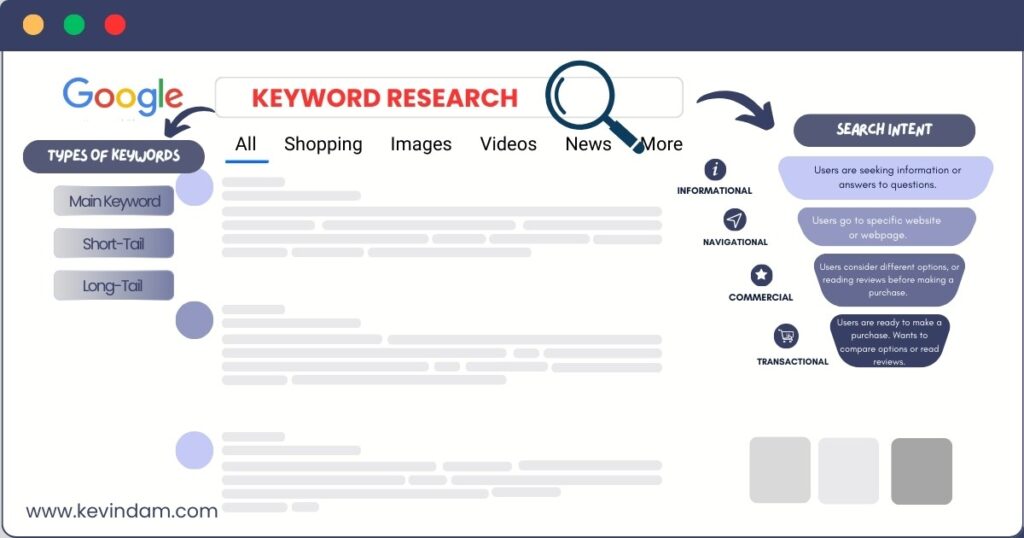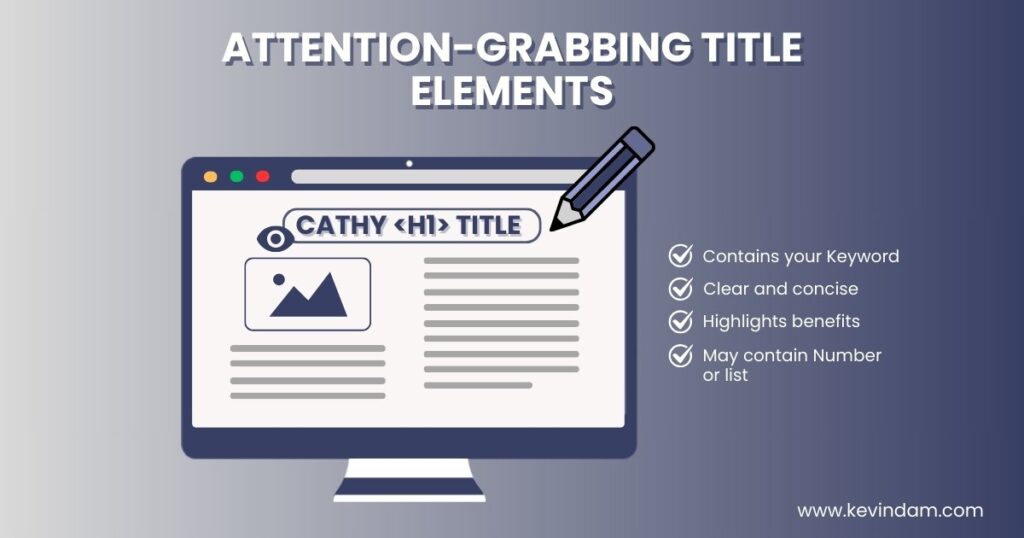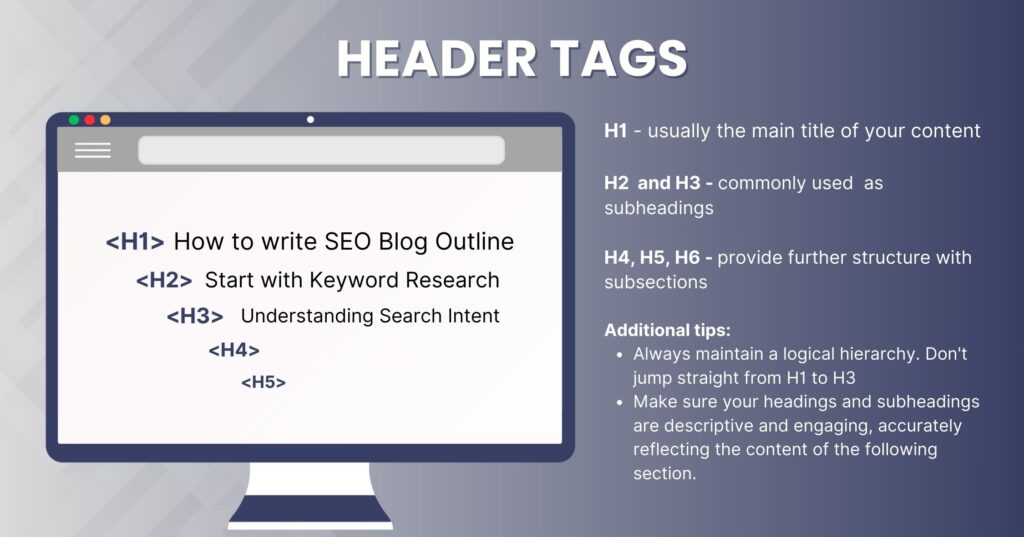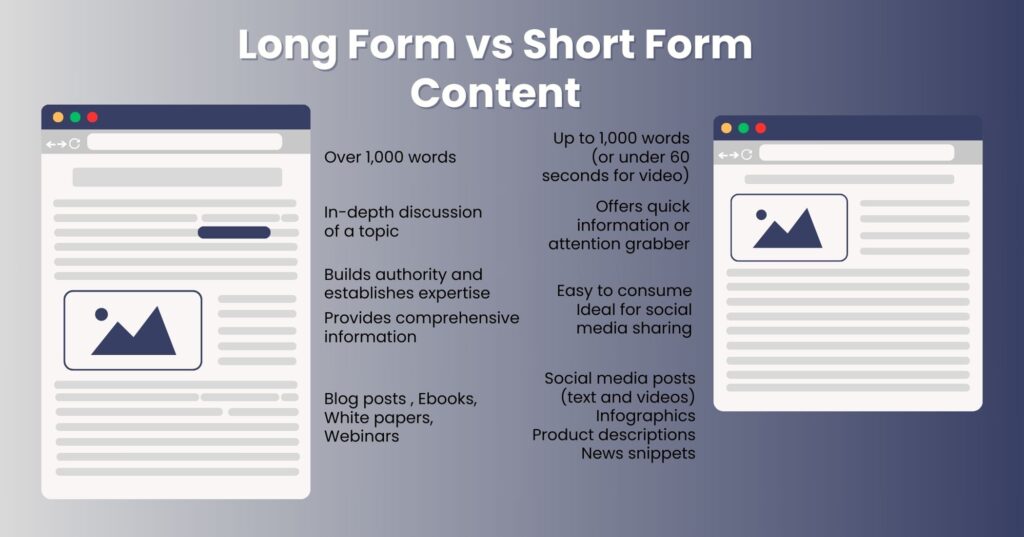
Last Updated August 14, 2024
How to write SEO-friendly Blog Outline: 7-Step Guide
An outline serves as a roadmap, guiding you through the intricacies of your content. It not only helps you organise your thoughts but also streamlines the process by breaking down complex ideas into manageable sections. We’ll explore the key elements that contribute to a powerful outline, including:
- Knowing your target audience: Through keyword research, understand their pain points and search intent to craft content that directly addresses their needs.
- Crafting captivating titles: Learn how to write informative, engaging, and keyword-rich titles that grab attention and boost SEO.
- Structuring your content for easy navigation: Explore the power of headings and subheadings to enhance readability and user experience.
- Considering format and length: Discover the strengths of long-form and short-form content and how to choose the optimal format to engage your audience and cater to search engine preferences.
- Incorporating reader-friendly elements: Bullet points, visuals, and strategic use of formatting elevate the reading experience and make your content scannable.
- Ensuring consistency with brand voice and personality: Learn how to tailor your outlines to reflect your unique brand identity.
- Integrating your process into a content marketing strategy: Discover how a well-defined SEO blog outline becomes the foundation for building a consistent and impactful content strategy.
So, let’s get started.
Start with Keyword Research

One of the essential ways to discover what your audience wants to read about is through keyword research. Keywords act as a roadmap, revealing what your target audience is actively searching for. Instead of guessing at topics, you can choose themes with proven search volume, ensuring your content has the potential to be seen This helps steer your content in the right direction by addressing topics that are actively sought after by your audience.
- Short-Tail Keywords vs. Long-Tail Keywords: Think of keywords like a spectrum. On one end, you have broad short-tail keywords, like “running shoes.” These terms have high search volume but are highly competitive and often don’t reveal much about the searcher’s intent.
On the other side are long-tail keywords, which are more specific phrases like “best running shoes for overpronation”. While they have a lower search volume, they are less competitive and offer a clearer picture of the user’s needs. By including a mix of focus and long-tail keywords in your outline, you can target a wider audience while ensuring your content remains relevant.
- Understanding Search Intent: Keywords go beyond just words; they reveal the intent behind a search. Are users looking for information (“best running shoes for flat feet”) or a solution (“how to tie a double knot”)? Understanding search intent allows you to tailor your content to their specific needs
- Understanding Audience Pain Points: Keywords can act as signals that draw attention to pain points or problems. Phrases like “fix slow computer” or “overcome social anxiety” highlight the challenges your audience faces. Your content becomes the solution they are looking for. Addressing topics that resonate with readers’ interests or challenges ensures relevance and engagement.
As we move forward into the process of crafting captivating blog content, our focus on identifying audience-centric topics lays the foundation for creating impactful and valuable material that speaks directly to the hearts of our readers.
Creating a Compelling Title

The title of your blog post is like the headline of a newspaper – it’s the first impression that grabs a reader’s attention and convinces them to dive in. But a great title goes beyond just being catchy. It also plays a crucial role in both SEO (Search Engine Optimization) and user engagement.
Here are some tips to craft titles that are informative, engaging, and keyword-rich:
- Start with Your Keyword: Incorporate your focus keyword naturally into your title. This helps search engines understand your content and improves discoverability.
- Keep it Clear & Concise: Aim for titles that are easy to understand and don’t exceed 60 characters (ideal for search results).
- Highlight Benefits: Focus on the value proposition of your content. What will readers gain from reading your post?
- Numbers & Lists: Titles with numbers or lists tend to grab attention and make your content seem scannable.
- Test & Refine: Don’t be afraid to experiment with different title variations and see what resonates best with your audience.
A well-crafted title hints at the value readers will derive from your content while piquing their curiosity. Ultimately, it should resonate with your target audience, offering them something they desire.
Structure your outline with Header tags
Headings and subheadings are the secret weapons for structuring your content and making it clear, scannable, and reader-friendly. They serve as a roadmap that guides readers along the way and lets them know what to expect as they read through your content.
Here’s how headings benefit your content:
- Enhanced Readability: Headings break down large chunks of text into clear and digestible sections, making your content easier to read and navigate.
- Improved Scannability: Headings allow readers to quickly grasp the main points and find the specific information they’re looking for without slogging through the entire piece.
- SEO Advantages: Search engines use headings to understand the structure and hierarchy of your content. Strategic use of headings can improve SEO by making your content more relevant to search queries.
Here’s how to structure your content effectively:
- Start with a strong H1, which is usually your main title. It should be clear, concise, and keyword-rich, accurately reflecting the overall content.
- Organise with H2’s, which act as the main section titles, dividing your content into logical themes.
- Use H3 subheadings to further organise information within each H2 section. You can even use H4s for very specific details, but avoid going overboard.
- Always maintain a logical hierarchy. Don’t jump straight from H1 to H3 – a clear progression from H1 to H2 to H3 (and potentially H4) ensures a smooth reading experience.
- Make sure your headings and subheadings are descriptive and engaging, accurately reflecting the content of the following section.
Consider Format and length
Long-Form vs. Short-Form
Understanding the strengths of each helps you make an informed choice:
- Long-form content is ideal for in-depth explorations of complex topics. Long-form content allows for comprehensive discussions, detailed explanations, and the inclusion of rich media like infographics or videos.
- Short-form content is perfect for quick tips, listicles, or breaking down complex concepts into bite-sized pieces. Short-form content is ideal for capturing the attention of busy readers or delivering a specific answer to a common question. The key to success is providing valuable information concisely and engagingly.
The best way to determine the ideal format? Do research. Analyse top-ranking articles for your chosen keywords. What format dominates the search results? Is it a comprehensive guide or a series of actionable tips? Aligning your format with the current landscape increases your chances of ranking well.
Reader-Friendly Formats
Regardless of long-form or short-form, prioritising reader-friendliness is essential. Here are some formats that make your content a joy to read:
- Bullets & Lists: Bullet points and numbered lists are fantastic for breaking down complex information into easily digestible chunks. They help readers grasp key points quickly without having to wade through dense paragraphs.
- Subheadings: As discussed earlier, headings and subheadings create a clear structure, making it easy for readers to navigate your content and find the information they seek.
- Bold & Italics: Strategic use of bold and italics can highlight important points or emphasize specific terms, guiding the reader’s eye and enhancing understanding.
- Visual elements: Visuals can break up text-heavy sections, improve engagement, and explain complex concepts more effectively. They can also instantly engage your audience and reinforce your points in a memorable way.
Incorporate essential elements for consistency
It should also effectively convey your brand identity throughout all your content. Most importantly, consistency ensures that the content you create directly addresses and provides solutions to the questions and needs of your target audience.
Tailor your outlines to brand personality
It’s not just about the words we use; it’s also about the way we say things, the stories we tell, and the perspective we bring. When developing a blog outline, it’s important that it reflects your expertise and personality. Consider the following factors:
- Tone: Is our style informal and friendly or formal and professional? This impacts how we communicate with our audience.
- Voice: What makes our writing distinctive? Is it light-hearted, humorous, authoritative, or thoughtful?
- Perspective: How do we approach topics? Are we known for providing practical advice, thought-provoking insights, or in-depth analysis?
By tailoring your outlines to match these elements, you can create content that resonates with your audience by staying true to yur brand identity.
For instance, our consultancy is known for its no-nonsense approach to SEO strategies. Our blog outline should reflect this by outlining practical steps and results-driven techniques.
It’s also crucial to infuse unique perspectives and experiences into the outline. After all, your personal experiences can be goldmines for connections with your audience, helping them see how real-world situations relate to the advice you’re offering.
Compelling CTAs (Call to Action)
A strong call to action is the final push that converts readers into engaged users. Don’t just settle for a generic “subscribe” button. Include CTAs in your outline that are tailored to your brand voice and naturally flow within the content. For example, a blog about remote work best practices could have a CTA that reads, “Empower your remote team – download our free e-book!”
Target Audience Awareness
Keeping your target audience in mind throughout the outlining process is crucial for consistent branding. Tailor your content and tone to resonate with their specific needs and interests.
Integrate Your Process into a Content Marketing Strategy
Consistency – it’s the invisible thread that weaves a memorable brand experience. a well-defined SEO blog outline serves as your blueprint for building a content empire.
Here are the advantages of having a collaborative team process:
- Shared Knowledge Base: Your streamlined process acts as a central repository of information. It communicates a structured workflow, ensuring everyone contributes content that aligns with the overall strategy.
- Streamlined Workflow: your process provides a clear roadmap for content creation. Everyone knows what visuals to create and ensures that content adheres to the established tone and target audience focus. This streamlined workflow boosts efficiency and reduces the risk of inconsistencies.
- Scalability & Growth: As your content marketing efforts expand, a well-defined strategy becomes invaluable. You can confidently delegate tasks and onboard new team members, knowing they have a clear framework to follow, ensuring consistent brand representation even as your content creation process scales.
A well-crafted SEO blog outline you built is a powerful tool, and integrating it into your content marketing strategy ensures consistency across all your content creation efforts, fostering a unified brand voice and experience for your audience. Remember, consistency is key, and by establishing a well-defined strategy, you can drive lasting success on your content marketing goals and fuel your brand growth.
Master the practice of Blog Outlining
When it comes to blog outlining, practising regularly is key to improving your skills. Like any skill, regular practice hones your proficiency and makes the process more efficient. Our ability to create well-organised and engaging content through effective outlining is directly linked to how often we practise this task.
Consistent outlining allows us to internalise the structure of an effective blog post. It helps us effortlessly identify key points, structure our content logically, and ensure a smooth flow from introduction to conclusion. Over time, this repetitive exercise becomes second nature and reduces the need for excessive editing and restructuring in the later stages of content creation.
Ready to streamline your blogging workflow and create high-performing content? Download our FREE blog outline template today! This handy tool will help you brainstorm key points, organise arguments, and craft a perfectly optimised blog post.
Conclusion
By following the steps outlined in this guide and embracing the power of consistent outlining practice, you’ll be well on your way to crafting high-performing blog content. Remember, a well-structured outline lays the groundwork for creating SEO-friendly blog posts that resonate with your target audience and drive lasting success for your content marketing efforts.


